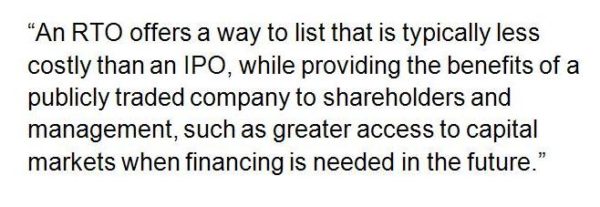
Conducting an initial public offering is sometimes taken to be synonymous with going public. However, an IPO is just one way to list on an exchange. Though other routes may not garner as much attention as a Facebook or Zynga IPO, they may provide speedier or less costly means toward a similar result.
While an IPO can be the best way to list in certain circumstances, smaller companies, especially, may be best served by taking a non-IPO route. Ultimately, a company’s board must select the best route by examining the characteristics of the company, the future capital-raising needs and the motivations for taking the company public.
The choice of exchange also is a factor. Canada offers three exchanges for public companies. The Toronto Stock Exchange (TSX) is best suited for larger companies, while both the TSX Venture Exchange (TSXV) and the Canadian National Stock Exchange (CNSX) cater to smaller companies.
The Initial Public Offering
The typical structure of an IPO is relatively straightforward. The company, together with its counsel, prepares a prospectus, which is the offering document under which it offers its shares for purchase by the public. A dealer is hired to act as an underwriter or agent to market or sell the shares. An application to list the shares for trading on an exchange is made at the same time. On approval of the listing application and on closing of the offering, the company’s shares begin trading on the exchange.
The main document in relation to the IPO, the prospectus, is written by the company’s legal counsel and requires the participation of management, auditors, the dealer (including its legal counsel), securities commissions and the exchange. It contains full, true and plain disclosure of all material facts relating to the shares being offered for sale.
The dealer and the company can arrange to conduct the financing element in different ways (whether on a “firm-commitment basis” or a “best efforts basis”), but regardless of the method chosen, both the dealer and company must be confident that the shares will successfully be sold to investors. This is particularly true for the dealer if the offering is sold on a firm-commitment basis where the dealer acts as a principal (rather than agent) and purchases the offered shares to attempt to sell to the public. In contrast, a dealer may act on a best-efforts basis, where the offered shares pass directly from the company to the investor, and the dealer, acting as agent, is not committed to purchase any unsold shares.
Though an IPO provides an opportunity to raise significant amounts of equity for the company, it also results in share dilution (meaning that the founders or major shareholders of the company lose a controlling interest in the subsequent public company). As well, an IPO may be an expensive and time-consuming process (for example, an underwriter’s commission will typically be between 5% and 7% of the total amount raised pursuant to the offering). Finally, the success of an IPO is tied to market conditions, carrying the risk that the financing will not be successful in the face of a market downturn.
In 2012, the TSX had 12 IPO’s (worth a total of $1.7 billion), the TSXV had 44 IPO’s (worth a total of $107 million) and the CNSX had five IPO’s (worth a total of $2 million).
The Reverse Take-Over
A reverse take-over, also sometimes known as a “reverse IPO,” is a route to listing on an exchange that, in contrast to the IPO, has a slightly more complicated structure but may be less susceptible to market fluctuations.
In addition to the private company wishing to list on that exchange, the RTO process requires the participation of another company, often a shell without any active business, which is already listed on the desired exchange and is willing to serve as the acquiror of the private company. A reverse take-over is structured around a reorganization of the capitalization of the acquiror, with the result being that the private company shareholders come to hold a substantial majority of the shares of the resulting public company in exchange for their private company shares. A substantial financing is not necessary to a listing by way of an RTO (in fact, a financing is not a required element at all).
An RTO offers a way to list that is typically less costly than an IPO, while providing the benefits of a publicly traded company to shareholders and management, such as greater access to capital markets when financing is needed in the future. Care should be taken in selecting the appropriate shell company, as shell companies with previous operating histories may carry unforeseen liabilities.
In 2012, there were 12 RTO’s of TSXV-listed companies and seven RTO’s of CNSX-listed companies. There were no RTO’s of TSX-listed companies.
The Capital Pool Company Program
Finally, the TSXV offers a specific program for companies wishing to list on the TSXV by way of an RTO. The capital pool company program (the CPC program) allows for the listing of capital pool companies, each having the sole mandate of finding and acquiring a private company.
Essentially, a capital pool company is specifically meant to be a vehicle for a private company to list on the TSXV. (The completion of an RTO transaction between the capital pool company and the private company is known as a “Qualifying Transaction”). The Qualifying Transaction is structured in a way that the shareholders of the private company become significant shareholders in the resulting public company. A financing is usually conducted by the private company in relation to the Qualifying Transaction in order to ensure there is enough capital to carry on the business of the private company.
While the CPC program transaction shares many of the advantages and drawbacks of a regular RTO transaction, CPC shells will require less due diligence as they have not had a previous existence as an operating business.
In 2012, there were 61 Qualifying Transactions under the TSXV’s CPC program.
Final Thoughts
The determination of the most appropriate route to listing involves an examination of the characteristics of the company, its anticipated capital-raising needs and the motivations for taking the company public. Additionally, the board, with participation of its advisors, should conduct a study to identify the best-suited exchange as well as an analysis of whether the company can meet the minimum listing requirements of that exchange.
Heenan Blaikie LLP’s securities group has extensive experience in taking companies public via the three methods discussed in this article. Two of the leaders of this group, Sonia Yung and Eric Levy, would be pleased to answer any questions you may have on the going public process.

_______________
Leave a Reply
You must be logged in to post a comment.




 Share
Share Tweet
Tweet Share
Share




Comment